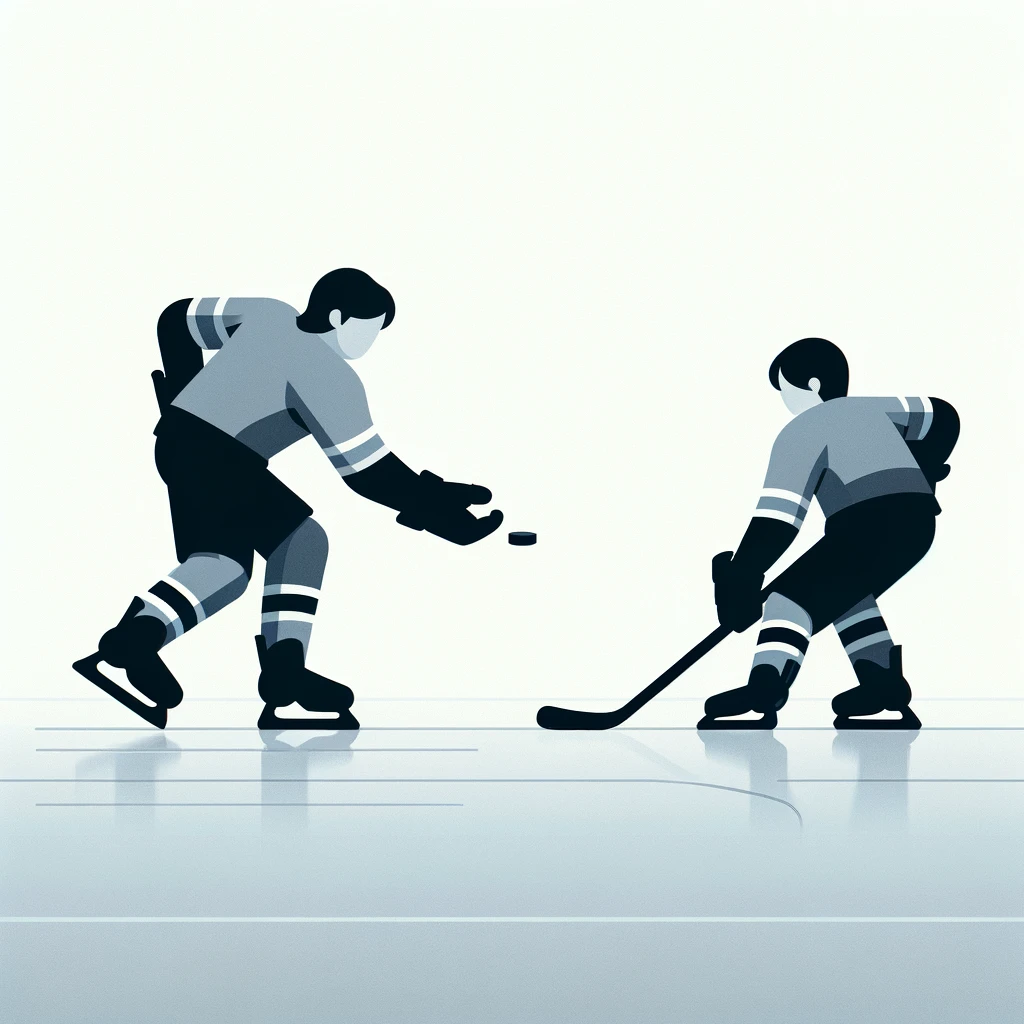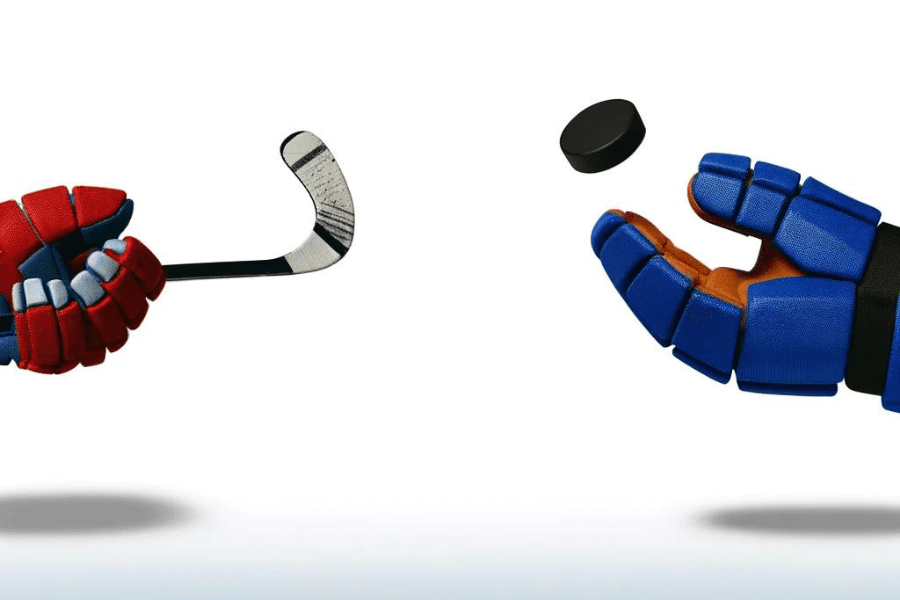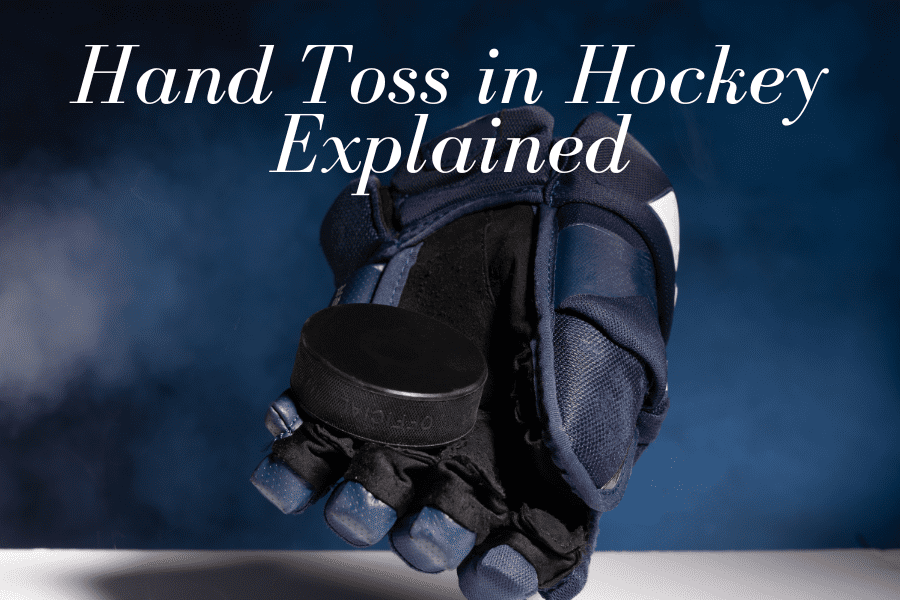What is a Hand Pass in Hockey?
We are going to explain the ins and outs of hand passes in Hockey. We will see how the game plays out differently for USA Youth Hockey compared to the NHL.
USA Youth Hockey: In the world of USA Youth Hockey, the rules around hand passes are pretty straightforward. Players are allowed to bat the puck out of the air or push it along the ice with their hands, but here’s the kicker – they can only do this magical move in their defensive zone. If a player tries this trick in the neutral or attacking zone, the whistle blows, and play stops for a face-off. It’s like saying, “Nice try, but let’s keep the game moving with our sticks, not our hands.” The idea here is to keep the game fair and prevent any sneaky advantages.
NHL Hockey: Now, over to the NHL, the game speeds up and the rules get a little more nuanced. In the NHL, players can also use their hands to pass the puck, but with a twist. Hand passes are a total no-go across the entire rink, including the defensive zone. If a player decides to get handsy with the puck and sends it to a teammate, the referees will whistle it down, stopping play, no matter where it happens on the ice. However, if this hand pass occurs within the defensive zone, play continues without a hitch, mirroring the youth rules in this specific scenario. It’s the NHL’s way of keeping the game flowing while ensuring no team gets an unfair edge.

The Main Differences:
- Zone Restrictions: The biggest difference lies in where these hand passes can occur. USA Youth Hockey is a bit more lenient, allowing these passes in the defensive zone, while the NHL applies a stricter rule, disallowing them in all zones but allowing continuation in defensive zones under specific circumstances.
- Game Flow: The NHL’s approach to hand passes aims to maintain a fast-paced, uninterrupted game flow, minimizing stoppages and keeping the action intense.
Zones during a Hand Pass in a Hockey Game
Hand pass rules in ice hockey vary depending on the zone in which the pass occurs.
In the defensive zone, a player is allowed to make a hand pass to a teammate without facing any penalties. This could potentially provide a strategic advantage for the defensive team to quickly move the puck out of their own zone and start a counterattack.
However, in the neutral zone and attacking zone, a different set of rules apply.
Let’s Break this Hand Pass Down:
Someone decides to grab or swat the puck with their hand. Here’s the scoop:
- If a player, not the goalie, grabs the puck and doesn’t drop it right away, the whistle blows, and the game pauses for a face-off. It’s like saying, “Oops, can’t do that! Let’s reset.”
- Now, if someone scoops the puck up from the ice with their hand while the game’s on, they’ll get a timeout (well, a minor penalty) for causing a delay. It’s like the game saying, “We don’t pick up the puck; we play hockey!
- There’s a special case by the goal. If a defender, again not the goalie, picks up or holds the puck in the goal area, the other team might get a chance to score without anyone trying to stop them (a penalty shot) or even get a free goal if it was super clear they were about to score anyway. Think of it as the ultimate “no-no” zone for using hands.
- Oh, and about passing the puck with hands to a teammate? Totally cool, but only if they’re hanging out in their own defensive zone. Do it outside that safe zone, and play stops for a face-off. It’s like the rule is saying, “Pass notes in your own area, or we’re stopping the game.”
- Lastly, trying to score by pushing the puck into the net with a hand? That’s a big no. Even if it bounces off someone else first, those goals don’t count.
Hand Passes in Defensive, Neutral, and Attacking Zones

In the neutral zone, if a player uses their hand to pass the puck to a teammate, a stoppage of play will occur. This is to prevent teams from gaining an unfair advantage by using their hands to control the puck and create scoring opportunities. Once play is stopped, a face-off will take place according to the last play rules.
A similar rule applies in the attacking zone. If a player makes a hand pass to a teammate in this zone, play will be stopped and a face-off will be conducted. Again, this ensures fair play and prevents teams from using hand passes to gain an unfair territorial advantage.
By understanding these hand pass rules in different zones, players can make informed decisions on when to pass the puck with their hands and when to use other techniques.
It is crucial for players to be aware of the rules and avoid making hand passes in the neutral and attacking zones to prevent unnecessary play stoppages and maintain the flow of the game.
The Implications of Hand Passes on the Game
When a Hand Pass Results in a Stoppage of Play
Hand passes in ice hockey can have various implications on the game. When a hand pass occurs in the neutral or attacking zone, play will be stopped and a face-off will be conducted to resume play. This stoppage of play can disrupt the flow of the game and give the opposing team an opportunity to regroup and strategize.
USA Hockey Regulations on Hand Passes
In ice hockey, a hand pass is a rule violation that occurs when a player uses their hand to intentionally direct or control the puck.
The hand pass rule applies to all players on the ice except for the goaltender. If a player closes their hand on the puck and does not immediately drop it to the ice, a play stoppage will occur and a last play face-off will be awarded.
A minor penalty for delay of game will be assessed to any player, except the goaltender, who picks the puck up from the ice with their hand during play.
Hand passes can also result in penalty shots or optional minor penalties in certain situations.
USA Hockey has specific regulations regarding hand passes.
According to these regulations, if a player closes their hand on the puck and gains an advantage, a minor penalty for handling the puck will be assessed.
This penalty emphasizes the importance of fair play and discourages players from using their hands to gain an unfair advantage.
Conclusion
Understanding hand pass rules in ice hockey is essential for hockey parents and fans alike. By familiarizing yourself with the regulations and consequences surrounding hand passes, you can gain a deeper appreciation for the game and ensure a fair and enjoyable experience for all.
Key Takeaways for Hockey Parents and Fans
1. Knowing when a hand pass results in a stoppage of play in the neutral and attacking zones is crucial. By avoiding unnecessary hand passes in these zones, you can help maintain the flow of the game and prevent unnecessary interruptions.
2. Familiarize yourself with the USA Hockey regulations on hand passes. Understanding the penalties for illegal hand passes, such as minor penalties for handling the puck, will enable you to better understand the calls made by officials during a game.
3. Recognize the importance of teaching young players about hand passes in youth hockey. Developing good sportsmanship and a strong understanding of the rules can help players enhance their skills, contribute to fair play, and foster a love for the sport.
The Similarity: Safety and Fair Play
Despite these differences, both leagues share a commitment to safety and fair play. Whether it’s a youngster just starting or a seasoned pro in the NHL, the rules around hand passes ensure the game stays fair, competitive, and safe for everyone involved.
FAQ
What is a Hand Pass in Hockey?
A hand pass in hockey occurs when a player uses their hand to intentionally direct or control the puck. It is a rule violation that applies to all players on the ice except for the goaltender. A violation though depending on youth vs. NHL hockey and which area the player made the hand pass!
What happens if a player makes a hand pass?
If a player closes their hand on the puck and does not immediately drop it to the ice, a play stoppage will occur and a last play face-off will be awarded. In addition, a minor penalty for delay of game will be assessed to any player, except the goaltender, who picks the puck up from the ice with their hand during play.
Are hand passes allowed in all zones in ice hockey?
The rules regarding hand passes in ice hockey vary depending on the zone in which the pass occurs. In the defensive zone, a player is allowed to make a hand pass to a teammate without facing any penalties. However, in the neutral zone and attacking zone, a stoppage of play will occur if a player uses their hand to pass the puck to a teammate.
What are the implications of a hand pass in ice hockey?
When a hand pass occurs in the neutral or attacking zone, play will be stopped and a face-off will be conducted to resume play. This can disrupt the flow of the game and give the opposing team an opportunity to regroup.
What are the consequences of making an illegal hand pass?
Illegal hand passes in ice hockey can result in penalties, disallowance of goals scored as a result of a hand pass, and other repercussions. USA Hockey has specific regulations in place regarding hand passes, including penalties for illegal hand passes.
Source Links
- https://www.usahockeyrulebook.com/page/show/1084666-rule-618-handling-puck-with-hands
- http://rulebook.hockeycanada.ca/english/part-ii-gameplay-fouls/section-10/rule-10-2/
- https://www.usahockeyrulebook.com/page/show/1085021-handling-puck-with-hands



